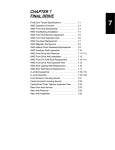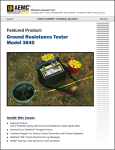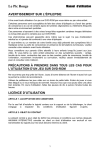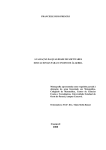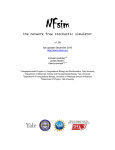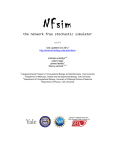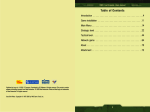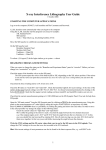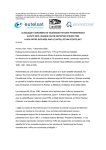Download Dau: user manual
Transcript
Dau
: user manual
Harun iljak
November 9, 2011
If you want to make a quick start with Dau, don't read the entire manual simply read the help le (i.e. part II of the manual). The manual is here to tell
you more about the game, the characters, history and mathematics.
Figure 1: In case you were interested: the license plates are from the Estonian
SSR
CONTENTS
CONTENTS
Contents
I
The History
3
1 Characters involved
1.1
Lev Davidovich Landau
. . . . . . . . . . . . . . . . . . . . . . .
1.2
Evgeny Mikhailovich Lifshitz
1.3
Igor Yevgenyevich Tamm
4
. . . . . . . . . . . . . . . . . . . .
5
. . . . . . . . . . . . . . . . . . . . . .
5
2 Origin of the game
2.1
The game is born . . . . . . . . . . . . . . . . . . . . . . . . . . .
2.2
What can be used? . . . . . . . . . . . . . . . . . . . . . . . . . .
II
4
The Implementation
8
8
8
10
3 Interface
3.1
Playing a single player game . . . . . . . . . . . . . . . . . . . . .
3.2
Playing a multiplayer game
. . . . . . . . . . . . . . . . . . . . .
4 Diculty levels
11
12
15
19
4.1
Easy level . . . . . . . . . . . . . . . . . . . . . . . . . . . . . . .
4.2
Hard Level
. . . . . . . . . . . . . . . . . . . . . . . . . . . . . .
19
4.3
Teorminimum . . . . . . . . . . . . . . . . . . . . . . . . . . . . .
19
III
The Mathematics
5 General solutions
19
20
. . . . . . . . . . . . . . . . . . . . . . . .
21
5.1
Iterated trigonometry
5.2
Factorials and trigonometry . . . . . . . . . . . . . . . . . . . . .
21
5.3
Binary logarithm . . . . . . . . . . . . . . . . . . . . . . . . . . .
22
6 Minimizing the functions set
21
23
6.1
Easy level of the game . . . . . . . . . . . . . . . . . . . . . . . .
6.2
Hard level of the game . . . . . . . . . . . . . . . . . . . . . . . .
23
6.3
The Teorminimum
23
. . . . . . . . . . . . . . . . . . . . . . . . . .
2
23
Part I
The History
Figure 2: Lifshitz (left) and Landau (right) on a car trip in the Caucasus region
3
1
CHARACTERS INVOLVED
Figure 3: Lev Davidovich Landau
1 Characters involved
Three curious characters appear in
Dau, and it would be fair to introduce them
here. Each one will be presented with a photo, brief biography and an anecdote.
Of course, it was hard to select only one anecdote per person (especially in case
of Lev Landau).
1.1
Lev Davidovich Landau
Lev Davidovich Landau (Baku 1908 - Moscow 1968), Soviet physicist, Academician, Hero of Socialist Labour, Stalin, Lenin and Nobel prize laureate. Friends
called him simply Dau. He won the Nobel prize in 1962 for his work on superuids. He is well known for his work in quantum mechanics, theory of phase
transitions, quantum electrodynamics...
Erudite and active thinker in every
meaning of that word. His school of theoretical physics was a great place for
making of brilliant scientists, his comprehensive exams in all branches of physics
called The theoretical minimum - shorter, Teorminimum. Only 43 men ever
passed all the exams, as you can see in the list in gure 4.
Landau once attended a session of the Russian Academy of Sciences at which
the notorious agronomist Trom Lysenko (the founder of "creative Darwinism")
gave a lecture on the so-called inheritance of acquired traits. When the talk was
over, Landau asked a penetrating question:
"You argue that if we will cut
o the ear of a cow, and the ear of its ospring, and so on, sooner or later
the earless cows will start to be born?" "Yes, that's right," Lysenko replied.
"Then," Landau continued, "how do you explain the virgins that are still being
born?"
4
1.2
Evgeny Mikhailovich Lifshitz
1
CHARACTERS INVOLVED
Figure 4: Landau keeping track of Teorminimum students
1.2
Evgeny Mikhailovich Lifshitz
Evgeny Mikhailovich Lifshitz (Kharkiv 1915 - Moscow 1985), Soviet physicist,
Academician, Stalin and Lenin prize laureate. His brother was Ilya Mikhailovich
Lifshitz, another well known physicist. Coauthored the Course of Theoretical
Physics with Landau, one of the rst people who passed Landau's Teorminimum,
made important contributions to general relativity, phase transitions and other
branches of theoretical physics.
On one of Bohr's visits to the USSR (gure 6) he was asked how he had
succeeded in making an excellent school of theoretical physics. His answer was
that he was never afraid to tell his students that he's a fool. Lifshitz was the
ocial translator and mistranslated it, saying He was never afraid to tell his
students that they are fools. Only after the academicians listening the lecture
started laughing, Lifshitz realized that he made a mistake and apologized. Pyotr
Kapitsa commented: No, Lifshitz, you didn't make a mistake. Exactly that is
the dierence between Bohr's and Landau's school of physics!
1.3
Igor Yevgenyevich Tamm
Igor Yevgenyevich Tamm (Vladivostok 1895 - Moscow 1971), Soviet physicist,
Academician, Hero of Socialist Labour, Stalin and Nobel prize laureate.
To-
gether with Pavel Cherenkov and Ilya Frank, Tamm won the Nobel prize in
1958 for the discovery of Cherenkov radiation. He worked on problems of thermonuclear reactors (plasma preservation, tokamak).
Tamm has nothing to do with Landau's game.
It's just that I loved that
photo shown in gure 7 - both Lifshitz and Landau are there, Tamm explains
something to them - and there's even a car in the picture! How convenient, you
5
1.3
Igor Yevgenyevich Tamm
1
CHARACTERS INVOLVED
Figure 5: Evgeny Mikhailovich Lifshitz
Figure 6: Lev Landau and Niels Bohr
6
1.3
Igor Yevgenyevich Tamm
1
CHARACTERS INVOLVED
Figure 7: Igor Yevgenyevich Tamm
must admit.
My favourite anecdote about Tamm: During the Russian revolution, he was
a physics professor at the University of Odessa in the Ukraine.
Food was in
short supply, so he made a trip to a nearby village in search of food. While he
was in the village, a bunch of anti-communist bandits surrounded the town.
The leader was suspicious of Tamm, who was dressed in city clothes.
He
demanded to know what Tamm did for a living. He explained that he was a
university professor looking for food. What subject?, the bandit leader asked.
Tamm replied I teach mathematics.
Mathematics? said the leader. OK. Then give me an estimate of the error
one makes by cutting o a Maclaurin series expansion at the nth term. Do this
and you will go free. Fail, and I will shoot you.
Tamm was not just a little astonished. At gunpoint, he managed to work
out the answer.
He showed it to the bandit leader, who perused it and then
declared Correct! Go home. Tamm never discovered the name of the bandit.
7
2
ORIGIN OF THE GAME
Figure 8: Landau, Lifshitz and Tamm
2 Origin of the game
There is not much to say about the game origins. Both Kaganov and Gorobets
in [2] and [1] tell roughly the same story.
2.1
The game is born
Kaganov writes in [2] about the game - Landau invented it, played it and told
others about it, encouraging them to play.
Rules are simple - in those days,
Soviet license plates looked like one in gure 1 - four digits were combined in
two pairs, separated by a hyphen.
Landau applied elementary mathematical
operations and functions on both sides using only digits given, in order they're
given so the hyphen could be replaced with a sign of equality. For instance, if
12 −√34, potential solutions would be 1 − 2 = 3 − 4 or
12 = 3 − 4... Kaganov wondered if this game always had a
the license plates were
1 × 2 = 3! − 4
or
solution - Landau's answer was negative - not because he proved that general
solution doesn't exist, but because he didn't solve all the license plates he saw!
So, do general solutions exist? Answer is in the part III of the manual.
2.2
What can be used?
Landau made it a rule: functions and operations used in the game should be
elementary and known to high school students. It's fairly obvious that dierentiation would trivialize the game, reducing every combination to
0=0
- but
since that's not elementary, it's not allowed. Similarly, integer part of a number,
denoted by
[]
and fractional part, denoted by
8
{}
also trivialize the game - so,
2.2
What can be used?
2
ORIGIN OF THE GAME
even if the high school students are aware of these functions, they would spoil
the fun - so, we're not going to use them.
That leaves us with basic trigonometry, inverse trigonometric functions, logarithms, square root, taking number to a power, factorial... Are they powerful
enough to solve any license plate? We'll see.
9
Part II
The Implementation
Figure 9: There is an Easter egg in the game - and I couldn't help myself, I had
to mention it in this manual. Anecdote says that Landau kept repeating silently
during one of Paul Dirac's lectures Dirac - fool (durak) until he nished with
the lecture. At the end Dirac turned to Dau and said - Sam durak! (You're a
fool yourself !)
10
3
Figure 10:
INTERFACE
Dau's main window
3 Interface
In case you skipped the rst part of the manual: Dau is a computerized version
of Landau's license plate game. You get two pairs of digits separated with a
hyphen (e. g. 12−34). Goal is to manipulate digits by using standard elementary
functions and mathematical operations√to make an equality - for instance 1−2 =
3 − 4 or 1 × 2 = 3! − 4 or 12 = 3 − 4. All given digits must be used exactly
once, no permutations allowed, no additional digits allowed either.
You could easily play Landau's game walking on the street (don't play and
drive, though!), but I wanted to make a PC game out of it - so you can play it
online with your friends or oine in your room without having to nd real cars.
Choice is yours, as shown in the gure 10.
As you may see, it is pretty self-explainable: The story of
Dau button opens
this manual, while the Help button opens just a part of it - namely, this part.
About button informs you about the author and technology used, while Quit
game button takes you back to the real world. As far as Single player game and
Multiplayer game buttons are concerned - explanation follows.
11
3.1
Playing a single player game
3.1
3
INTERFACE
Playing a single player game
Choosing single player game in the main menu takes you to the options screen,
shown in gure 11. Four options are available for single player game - rest of
them are disabled since they are related to the multiplayer game.
Number of rounds:
how many license plates do you want to solve in the
game - options are 1, 5, 10, 20 or unlimited (default). Unlimited means
the game ends when you click the Quit game button, there is no limit on
the number of rounds.
Time per round (sec):
how much time will you have for each license plate
- options are 10, 20, 30, 60 or unlimited (default). Unlimited means the
round ends if you skip it clicking on an appropriate button (adds nothing
to your score) or give a correct answer (adds one point to your score). If
10, 20, 30 or 60 is chosen, round also may end if the time runs out (adds
nothing to your score).
Level of diculty:
how hard do you want the game to be - options are
Easy (default), Hard or Teorminimum. Levels are described in detail in
section 4. For now we'll just say that easy level gives you the biggest set
of functions and operations for use on the digits, while that set is reduced
in other two levels.
Your character:
since
Dau is designed as a two player game, you may
choose what character will you be - Landau (default) or Lifshitz. It makes
no dierence in the single player game - just tells the computer whose
score should it increase after every correct answer.
After conrmation of preferred options, game screen appears.
Depending
on the rules chosen it may look dierent (gures 12, 13, 14). Left corner box
tracks score, shows time elapsed in current round and what is the current round.
Buttons under it are the in-game menu.
Resign round:
skips the current round, you don't get points for the round
skipped. New round starts if it wasn't the last round, and if it was - the
game ends.
Ask Tamm!:
gives you a solution for current round, using binary logarithm
(a window appears, as shown in gure 15). This option is enabled only on
easy level in single player, since it is considered a warm-up mode of play.
Help:
opens this part of user manual, just like the Help button in the
main menu.
Quit match:
ends the game, nal score displays in a window (gure 16).
Same window appears when the game ends in its natural course (i.e. when
the last round ends).
12
3.1
Playing a single player game
3
Figure 11: Single player options
Figure 12: Game screen - easy level
13
INTERFACE
3.1
Playing a single player game
3
Figure 13: Game screen - hard level
Figure 14: Game screen - Teorminimum level
14
INTERFACE
3.2
Playing a multiplayer game
3
INTERFACE
Figure 15: Tamm answers!
Under the in-game menu is chat box - disabled in single player game. On
the right we have (top to bottom) a status bar, display of current license plate,
boxes for entering mathematical expressions, button for conrmation of entry
and a calculator pad with a double meaning - one is possibility of entering
digits, functions and operations via that pad in boxes, and the other one is
showing what can be used in the round (digits not appearing on the plate
are automatically disabled, and so are the functions/operations which are not
allowed at certain diculty level). Mathematical expressions can also be entered
in boxes using the real keyboard (most players will probably do so, since it's
faster).
If you enter a valid solution, a green message of approval appears in the
status bar and new round starts (or the game ends, if it was the last round).
If solution is invalid, you will get a red message describing the type of mistake
(whether you used additional digits, illegal functions, changed digit order, or
simply made a typing error).
3.2
Playing a multiplayer game
As you might have expected, multiplayer game has a lot of in common with single
player game. Options dialog is the same as before - but additional options are
available, as you can see in gure 17. It's worth mentioning that in a multiplayer
game, computer of the player who chooses Landau as the playing character takes
the role of game server, while Lifshitz takes the role of game client (that's just
a technical note, without any practical eect on the game itself ).
Chat:
in-game chatting in
Dau can either be disabled (default) or enabled.
15
3.2
Playing a multiplayer game
3
Figure 16: End of game
Figure 17: Multiplayer options
16
INTERFACE
3.2
Playing a multiplayer game
3
INTERFACE
Figure 18: Rules oer
Rules:
two types of game rules are possible: Faster player wins (default)
and No need to hurry. In the rst scenario only one player can take the
point in one round, and as soon as one answers correctly, that round ends
(or when time expires, or after both players give up the round - then none
of the players gets the point). In the second one, round doesn't end before
both players give it up, answer correctly (or the time expires), so both can
get the point in one round.
Your port #, Opponent's IP, Opponent's port #:
player connection. Default port number for
data needed for multi-
Dau is 31416.
If there is a
need to change it, you can always do it in this dialog.
From the moment when player selects Multiplayer game in main menu, port
31416 (or the port (s)he selects) starts waiting for invitations from other players.
Such invitations are sent by clicking the Oer rules button in this dialog. As
soon as a set of rules is oered to a player, (s)he gets a message like in gure
18, where the other player is identied with IP address (s)he uses. If the oer
is accepted, game begins on both computers. If not, the player who oered the
rules is informed about the other player's refusal.
In-game messages and interface are same as in single player game (see gures 19 and 20 for an example). It is worth mentioning that you are informed
via status bar about every correct answer, round skipping, or match quitting
done by your opponent. If one of the players leaves the game, other gets that
information and game ends.
17
3.2
Playing a multiplayer game
3
INTERFACE
Figure 19: One player's screen in a multiplayer game
Figure 20: Other player's screen in the same game
18
4
4 Diculty levels
Most games have certain diculty levels.
DIFFICULTY LEVELS
Dau has three - easy,
hard, and
teorminimum. Teorminimum could be considered hardest, although some may
claim that hard level is somewhat more dicult than teorminimum.
4.1
Easy level
Basically all functions which we discussed in section 2.2 of this manual are
allowed. muParser is used for parsing of expressions - all used functions except
for factorial are implemented in muParser (factorial and later double factorial
are implemented in in
Dau separately). As you can see in gure 12, this means
you can use addition, substraction, multiplication, division, take
x
to power
y,
put decimal point between digits, place brackets, take square root, exponentiate
ex , take logarithm base 10 (lg), base e (ln) and base 2 (lb), sine, cosine, tangent,
inverse sine, inverse cosine, inverse tangent, factorial.
4.2
Hard Level
In the hard level, trigonometry is not allowed. Exponentiation
other than
lg,
ex ,
logarithms
as well as decimal point placing also cannot be used.
On the
other hand, use of double factorial is allowed (gure 13).
4.3
Teorminimum
Add trigonometry to hard level, but take away double factorial, addition, multiplication, division, rising to power - and you get Teorminimum (gure 14).
19
Part III
The Mathematics
Figure 21: In case you wondered what was the logo that appears in the game, on
the calculator pad - it is a tribute to the rst Soviet pocket calculator Elektronika
B3-04
20
5
GENERAL SOLUTIONS
5 General solutions
As we pointed out before, there are general solutions, which you can use to solve
any license plate combination. Three of those will be presented here. What is
the point of such solutions? On one hand, they ruin the fun of the game, since
you don't have to use your imagination anymore - while on the other hand
looking for new general solutions gives a totally new dimension to the game.
5.1
Iterated trigonometry
2
function
2
1
x+cos x
2
tan2 x + 1 = sin cos
2x
√ = cos2 x = sec x, it is
2
f (n) = n + 1 = sec arctan n. Taking square roots
Knowing that
easy to make a
in this equality
yields
√
√
n + 1 = sec arctan n
Iterated use of this formula makes it possible to transform the smaller number on the plates into the larger one, making the necessary equality hold. This
was the solution Kaganov presented to Landau (after one of the Kharkiv mathematicians found it, according to [2]).
Gorobets in [1] noted that secant isn't in Russian high school curriculum
anymore, and therefore the solution isn't valid today. In one of the articles from
Nauka i zhizn
reprinted in [1] S. N. Fedin gives an equivalent formula to the
previous one but without secant, which uses the fact that
√
tan arccot x =
√
n + 1 = tan arccot cos arctan n
Note, however that neither of these two variants can be used in
1
x:
Dau since
cotangent, inverse cotangent and secant are not available (partly because they
were not available in muParser, partly because they don't put them on calculators these days!). That doesn't mean the formulae are completely inapplicable:
think of another way to make a reciprocal (I'm not going to give away those
small tricks, nd them yourself !)
I. Dobganchuk has shown that using
√
+, −, ×, :, , lg, log
and factorial one
can either solve a license plate or reduce it to one of three forms:
or
√
2−
5.2
√
3,
as noted in [1].
Factorials and trigonometry
You may know by heart that
360
√
√
0 − 3, 0 − 2
for all
n ≥ 6.
6! = 720. Since 720 = 2 · 360, n! is divisible by
sin n!° = 0 for such n and that gives us a
This means that
simple idea - we can reduce any two digits down to 0 (if one is zero, we simply
multiply them, if none is zero - we use this trigonometric identity) and obtain
trivial
0=0
equality. This solution was also introduced by Gorobets.
As you could have guessed, you can't apply this general solution in
since implemented trigonometric functions work with radians.
Dau
I could have
implemented alternative functions for angles in degrees, but it would spoil the
fun. If anyone wants to use such functions, (s)he can edit the source code.
21
5.3
Binary logarithm
5.3
5
GENERAL SOLUTIONS
Binary logarithm
The following solution is mine - as introduced in [3].
It uses the fact that
log2 2 = 1, log2 1 = 0, log2 4 = 2 so it's easy to convert a 4 into a 2, a 2 into a 1,
and 1 into a 0. That way one can make trivial 0 = 0 equalities whenever sum,
dierence or quotient of a pair of digits is 0, 1, 2 or 4. Only 5 pairs of digits
haven't got that property, but they can be reduced to 2, 1, 0 using square root
and/or factorial.
How can we use
log2
when we can't use additional digits (and we need a 2
for logarithm's base there)? According to the ISO standard, binary logarithm
(logarithm with base two) is special, just like logarithm with base 10 and with
base
e:
all three have special symbols:
lg
for base 10,
ln
2. This indicates the importance of these bases (10 and
for base
e
e,
lb for base
earned their special
place through centuries, while base 2 became important in the second half of
the last century, with development of computers and theory of information).
This solution can be used in
Dau (only on the easy level, though - since ld
is not allowed on upper levels). As you may have noticed, this is the solution
you get when you
Ask Tamm!
22
REFERENCES
6 Minimizing the functions set
Question whether it's easier to play Landau's game with more or with less
functions allowed is open for discussion - I chose to implement three levels of
diculty in
6.1
Dau in form of three sets of functions allowed.
Easy level of the game
With all functions and operations listed in 4.1 all possible license plates are
solvable (as we've seen, general solutions from 5.1 and 5.3 are applicable). Still,
some of the functions are almost never used, and some seem redundant - in the
hard level, they are disabled.
6.2
Hard level of the game
With functions listed in 4.2 not all license plates are solvable. Double factorial is
added to reduce number of unsolvable plates, but I assume there are still more
than a few in the game - they make the game harder, since you don't know
where you must concentrate and nd the answer, and where trying is futile.
6.3
The Teorminimum
This level is named after the famous Landau's exam but has no other connection with it.
It forces the player to use logarithms intensively in order to do
everything - multiplication, division, exponentiation, powers, roots, making reciprocals - everything can be done using logarithms (here lies the answer to
questions where's the
logy x
button,
y
√
x
button, etc in all levels - manipulate
logarithms). Thanks to the fact that trigonometry is allowed in this level, all
plates are solvable, using general solution from 5.1. That formula does not have
to be iterated too many times in light of Dobganchuk's analysis.
References
[1] B. S. Gorobets, Krug Landau, Letnii Sad, Moskva 2006.
[2] M. I. Kaganov, Landau's license plate game, Quantum, Vol. 3 No.
4 (1983)
[3] H. iljak, Landau's game - solution for the 21st century, submitted
to Matemati£ko-zi£ki list Zagreb, 2011
23
























